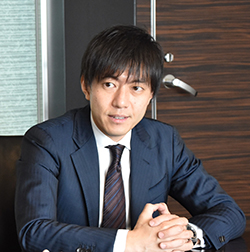External Evaluations and Initiatives
SoftBank has gained authentication from domestic and overseas organizations by promoting ESG initiatives,
and endorses ESG related initiatives.
Third-party opinion
Third-party opinion on disclosure of information by SoftBank Corp.

Kenji Fuma
CEO, Neural Inc.
Professor, Shinshu University Green Society Collaborative Innovation Organization
Kenji Fuma is a founder and CEO of Neural Inc, a strategy and management consulting firm in corporate sustainability and ESG investment, established in 2013.
Master of Liberal Arts in Sustainability, Harvard University
MBA in Global Management, Thunderbird School of Global Management
Certified Sustainability Practitioner, CMI
Overall summary
In addition to disclosing ESG information on SoftBank Corp. website, it is compiled into three reports: “Audited Consolidated Financial Statements,” “Integrated Report,” “Sustainability Report,” and “ESG Data Book.” Additionally, a “Corporate Governance Report” is also issued.
On the website, there is also a “comparison table” for GRI Standards, SASB Standards, ISO 26000, and TCFD, demonstrating a strong willingness to reference international standards and enhance information access for visitors. Efforts should be made to further improve information access from the perspective of visitors, such as refining the system for handling important information for each disclosure medium.
Governance
The company has established a governance structure to integrate its growth strategy and sustainability initiatives. Within the Board of Directors, important matters related to sustainability, including climate change and human capital, are deliberated and resolved. As the highest decision-making body, the Board has established a system to oversee the progress of sustainability initiatives. Additionally, although it is a company with an audit committee, it has optionally set up a nomination committee and a compensation committee with a high proportion of independent outside directors.
In addition, as a parent-subsidiary listed company, a special committee consisting solely of independent outside directors and an ESG Promotion Committee chaired by the President and CEO are established as advisory bodies to the Board of Directors, which is a unique feature of the company aimed at protecting the interests of minority shareholders. Regarding directors' remuneration, the Company has been strengthening disclosure of base remuneration and performance-linked remuneration, etc.
On the other hand, disclosure regarding the incorporation of sustainability indicators into performance-linked remuneration is limited. Disclosure of policy shareholdings is very comprehensive, with a very high level of disclosure of ownership policies, status of holdings, and reasons for holdings.
Strategy
The company has identified six material issues based on the concept of double materiality: “Building society and industry through DX,” “Connecting people and information to create new excitement,” “Creating new businesses through open innovation,” “Contributing to the global environment with the power of technology,” “Building high-quality social communication networks,” and “Developing a resilient management foundation.”
Based on these identified material issues, the company has formulated a growth strategy called “Beyond Carrier” and a long-term vision of “Provide Next-Generation Social Infrastructure essential for Development of a Digital Society” to simultaneously realize a sustainable society and increase corporate value, emphasizing its lead in the field of AI and its use of renewable energy as a distributed power source. It can be said that the integrated process from materiality to strategy formulation is highly effective.
Risk management
The company convenes a Risk Management Committee every six months, comprising the President & CEO, the Executive Vice President & COO, the Managing Executive Officer and CFO, among others, along with attendance from auditors and heads of relevant departments. This committee manages risks associated with identified material issues.
Furthermore, as part of the executive structure, the company has established the Information Security Committee, Human Rights Committee, Environment Committee, and Committee for the Promotion of Women in the Workforce. In risk assessment, individual risks are classified based on the likelihood of occurrence (probability of occurrence) and the potential magnitude of impact (severity of impact), and the company clearly defines its risk appetite (types and quantities of risks to be accepted) for business planning purposes. Additionally, the internal audit department independently audits the overall risk management framework and its status.
Indicators and Targets
The company has set individual key performance indicators (KPIs) for all six identified material issues and publicly discloses progress annually. Regarding climate change goals, the company aims for net-zero emissions by 2030 for Scopes 1 and 2, and by 2050 including Scope 3 emissions, and has applied for approval from the Science Based Targets initiative (SBTi).
In the field of natural capital, the company has set two additional goals: planting trees covering an area greater than the development area in nature conservation zones, and recycling or reusing 12 million information devices from fiscal year 2020 to 2025. Regarding the goal for the proportion of female managers, the company aims for a rate of over 20% by fiscal year 2035.
Overall assessment
The company's governance and risk management framework from an ESG perspective can be considered very robust. Moreover, they have clearly outlined strategies and set detailed KPIs for significant themes, indicating a comprehensive practice of PDCA (Plan-Do-Check-Act).
Looking ahead, I would like to point out the importance of fostering talent both internally and externally to achieve the two pillars of critical issues: “solving social issues through business” and “solving social issues through corporate activities.” As the necessity for “just transition” increases globally from both digitalization and sustainability transition perspectives, there is a shortage of individuals capable of realizing this, both domestically and internationally. Therefore, talent development and capacity building are essential.
I would like to see the company further develop the talent development mechanisms it has cultivated, while skillfully utilizing digital tools, to not only nurture internal talent but also take the lead in developing talent across society as a whole.
March 2024